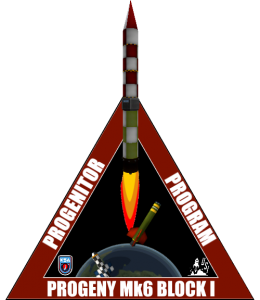 Another flight was put together to further explore the properties of the hazardous radiation region found above our planet. All previous launches had occurred sometime during the daylight hours while this flight was scheduled to occur during the middle of the night. Scientists had several theories regarding why the radiation data from this sub-orbital trajectory would be different, but we will address them in a later report once they have finished working through the new data as well as the old. Here we will focus solely on the performance of the rocket during the mission.
Another flight was put together to further explore the properties of the hazardous radiation region found above our planet. All previous launches had occurred sometime during the daylight hours while this flight was scheduled to occur during the middle of the night. Scientists had several theories regarding why the radiation data from this sub-orbital trajectory would be different, but we will address them in a later report once they have finished working through the new data as well as the old. Here we will focus solely on the performance of the rocket during the mission.
The Flight
No delays led up to an on time launch last Friday at precisely 16:51:00.04 local time when the lower 0.625m solid fuel booster lit off to push the rocket off the launch base. Ascent through to booster engine cutoff for the third stage liquid fuel engine was nominal compared to past launches, showing no significant deviation from event times or in the rocket’s angle of attack while spinning to stay stabilized. The rocket entered space 1m28s after launch, just 10ms after BECO. It maintained proper orientation throughout the 9 minute climb to 522.368km apokee and all the way back down to atmospheric interface at L+19m56s.
Entering engine-first, it passed through a Max Q of 402.228kPa before deploying air brakes to slow its descent in anticipation of parachute deployment. The flight computer crashed due to a software error when the chute was released, but it successfully deployed fully and the recovery ship MSV Tongjess was in visual range to watch the splashdown occur at L+21m19s to conclude the mission. The rocket was recovered from the sea surface under darkness and rough seas, much to the credit of the Tongjess’ crew and returned safely to KSC.
The Analysis
As we said earlier, because this was part of a larger ongoing mission to study the space radiation danger that will be covered in a separate report. Besides that facet of the mission and the obvious software anomaly the only significant portion was the performance of the air brakes under extreme stress.
Air Brakes
Engineers used data from past flights to begin building computer models of the rocket re-entering the atmosphere. Through various runs, each taking several hours to compute, they determined the air brakes, and the fuel tank they were attached to, could withstand over 400kPa of pressure when fully extended. Their work was put to the test this past launch, as previous flights had seen the air brakes extend gradually throughout the rocket’s descent. As we saw on the last flight however, this was not sufficient enough to slow the rocket in time if it were to come down over high terrain. Even with the full extension of the air brakes it still took until 2.752km ASL before the rocket’s speed slowed enough to make it safe for the chute to be released. This gives us a narrow margin for recovery over land when launching future missions into inclined trajectories.
Unfortunately due to the abnormal nature of the Mk6 Block II’s re-entry on its maiden flight and subsequent breakup, we don’t know how extreme pressures will get if it were to return engine-first as it should have. Engineers have worked to model this as well but they say they don’t trust the results enough to stand by them. We’ll have to wait for data from another flight before we can determine for sure whether air brakes could help us recover a Block II rocket.
Flight Computer Crash
Thankfully the software crash was not due to a serious issue, just a minor bug in the code that prevented the function that monitors the chute status to be removed from the active loop after deployment. This meant the next time it checked on the chute, which was already deployed, it did not find it properly and crashed the program. Logic errors like these are normally found by simulating launches against the software, but not always as circumstances during the actual flight can sometimes be outside what is expected. Regardless, the mistake has been fixed for future flights.
Future Plans
Currently as this report is written the KSC remains shut down down to excessive heat on the surface. While we can continue to work on operational logistics and planning and writing up reports like these, actually building the rockets and preparing the launch site for future missions has been put on hold, pushing back our planned launch schedule for two more Mk6 Block I flights. They will both follow the same flight profile used on this launch – at this time we have no further flight testing we wish to otherwise perform during the missions. There will be a very slight weight difference in how the payload section of the rockets are constructed but we don’t see that being an issue during flight. At the same time though we are prepared to be surprised and learn yet more new things.







